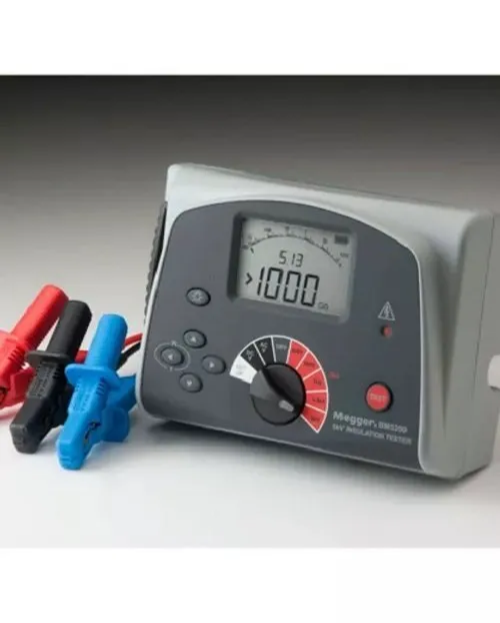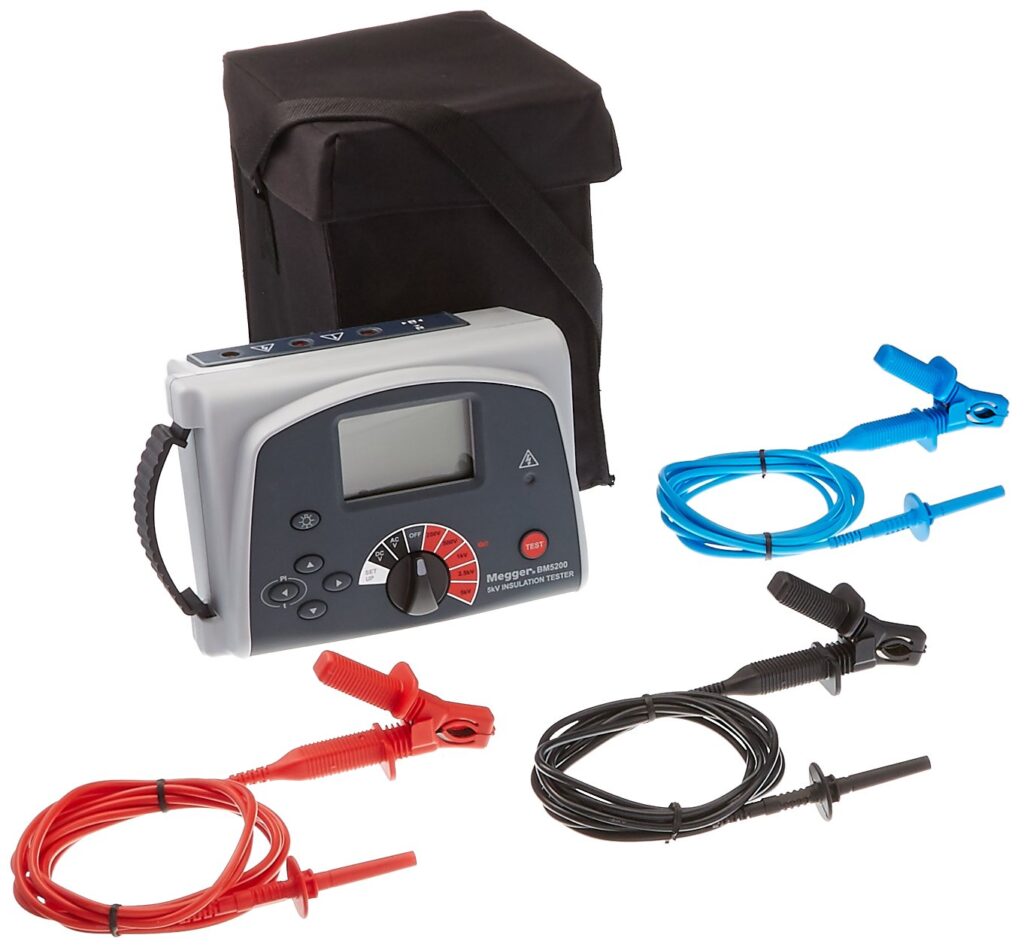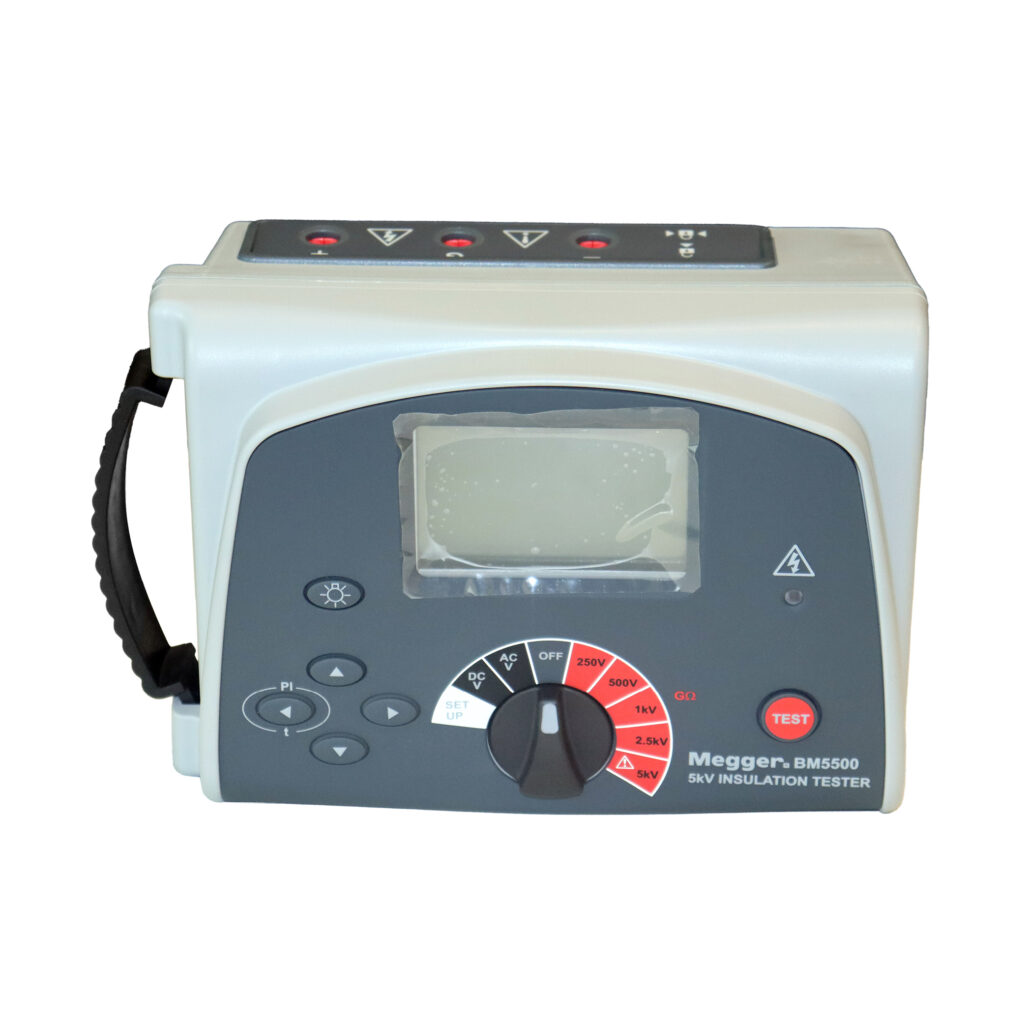
Adiradh offers 5 KV Insulation tester ,Megger make Model : BM5500 is a mains powered as well Builtin battery operated . These instruments have digital and analogue arc display, designed for high voltage insulation resistance testing in the maintenance and servicing of cables, rotating plant machinery, transformers, switchgear and industrial installations. DC insulation tests are performed at 250 V, 500 V, 1000 V,2500 V and 5000 V . Megger BM5500 Insulation resistance measuring range is 100 kΩ to 1000 GΩ. Automatic discharge for capacitive circuits under test is provided and decaying voltage displayed. 5 KV Megohmmeters are high-voltage, line-operated instruments and they provide a continuously variable test voltage for highly sensitive insulation-resistance measurements of all types of electrical equipment and power cable.
The guard terminal in 5kV Digital Insulation resistance tester BM5500 can be used to minimise the effects of surface leakage and hence erroneous measurements when carrying out insulation resistance tests. Three insulation resistance (IR) test modes are provided, (InS, PI and t) and available in any IR test range. In IR mode (InS) tests in 5KV IR Tester are initiated by pressing and holding down the TEST button for two seconds and terminated by a second press of the button.Digital Adiradh offers best discount price for 5KV Insulation Testers in India
A Polarisation Index (PI) mode performs a ratio metric test that calculates the ratio of insulation resistance at ten minutes to insulation resistance at one minute. The IR test timer (t) mode facilitates a single fixed time test based on the set time interval t. For capacitive test objects the instrument will automatically discharge through an internal resistor and indicate voltage across the terminals in the range 25 V to 600 V with higher voltages indicated by ‘>600 V’.

5KV Insulation tester -BM5500
■ 1 TΩ, 1.4 mA, 5 kV digital insulation tester with digital and analogue display
■ Five ranges; 250 V, 500 V, 1000 V,2500 V and 5000 V
■ Insulation (InS), Polarisation Index (PI) and variable timed test (t) modes
■ Selectable DC or AC voltmeter functions
■ Guard terminal to shunt surface leakage currents
■ CAT III 600 V safety rating
Digital 5KV High Voltage Insulation Tester BM5500 Applications
Electrical insulating materials deteriorate with time leading to breakdowns and costly repair bills. Insulation resistance testers apply a regulated DC voltage across the insulation and measure current flow through it applying Ohm’s law to calculate insulation resistance. 5KV Megger BM5500 tester uses includes:
Product test and qualification
Installation of equipment
Routine maintenance
Problem resolutions
Insulation testing with high voltage DC affects insulation polarisation such that consecutive testing without complete discharge of the unit under test will yield different results in Megger 5000v Insulation Tester ..Care should be taken to always employ the same process and technique of connecting to and testing an insulator to be able to trend results in Digital 5KV High Voltage Insulation Testers.Portable insulation resistance testers and megohmmeters are designed to help prevent hazards such as electric shock and short-circuits caused when the insulation in electrical devices, parts, and equipment used in industrial plants, buildings, and other settings degrades over long periods of use.

5KV Insulation resistance Tester-BM5500

5KV Digital Insulation tester BM5500
Brochure for Insulation resistance tester BM5500
5KV Digital Insulation resistance tester BM5500 user manual

5KV Insulation resistance tester-BM5500
| Insulation range | 100 kΩ to 1 TΩ |
| Nominal test voltages | 250 V, 500 V, 1000 V, 2500 V, 5000 V |
| Terminal voltage accuracy | < 1000 V 0…+10% of nominal voltage ≥1000 V 0…+5% of nominal voltage |
| Insulation accuracy | Up to 1 GΩ: All ranges ±5% ±2 digits Over 1 GΩ: 5000 V ±5% ±0.04% per GΩ 2500 V ±5% ±0.08% per GΩ 1000 V ±5% ±0.2% per GΩ 500 V ±5% ±0.4% per GΩ 250 V ±5% ±0.8% per GΩ |
| Short circuit/charge current | 1.4 mA ±0.5 mA |
| Maximum capacitance of load | 5 μF |
| Voltmeter accuracy | 3% ± 3 V |
| Frequency measurement | 45 Hz to 65 Hz |
| Frequency measurement accuracy | ±2 Hz |
| Voltmeter range | Up to 600 V a.c. or d.c. |
| Power supply | AC as well Built-in battery operated |
| Battery life | 5 lbs (2.3 kg) |
| 5 hours @ 5 kV into 100 MΩ | AC as well Built-in battery operated |
| Guard | 2% error guarding 5 MΩ leakage on 100 MΩ load |
| Operating temperature range and humidity | -20 to +55 °C |
| Humidity | 90% RH, 0 to 40 °C 70% RH, 40 to 55 °C |
| Storage temperature range | -20 to +65 °C |
| IP rating | IP40 |
| Safety protection | Insulation Cat III 600 V |
| EMC | The product conforms to IEC 61326 |
| Dimensions | 220 mm x 115 mm x 163 mm |
| Weight | 1.45 kg |
Insulation resistance testing Techniques
Two techniques can aid in insulation condition assessment. The first is to apply the voltage in increasing steps. Degraded insulation will show a declining IR value as the test voltage increases. For accurate results, dwell time at each step should be controlled. To make this an easy test Insulation resistance tester should have feature of automatically step up the voltage at programmed intervals. Another assessment technique is to compare IR readings with previous test results. Since the megohmmeter uses a very low test current, it does not damage the insulation. Periodic IR testing will identify insulation degradation over time and the need for preventive maintenance. An accurate comparison requires measurements at the same voltage and dwell time. Moisture affects the IR readings, so care should be taken to perform the tests under similar temperature and humidity conditions.
Insulation resistance testing parameters
Two parameters derived from insulation resistance measurements are dielectric absorption ratio (DAR) and polarization index (PI). Advanced digital megohmmeters have dedicated functions to measure and display these parameters. DAR is the IR at 60 seconds divided by the IR at 30 seconds. A value less than 1 shows the resistance is decreasing with time, which indicates a failing DUT. The polarization index is used on motors and generators to assess the amount of impurities in the windings and their cleanliness. PI is the IR at 10 minutes divided by the IR at 1 minute. Some equipment standards specify minimum PI values. A ratio greater than 1.5 is generally adequate.
Choose an insulation tester?
Test Voltage
You should also base your voltage requirements on the rated voltage of the equipment you are working with, specifically whether or not you will be performing tests at or above rated, i.e. stress tests.Something to keep in mind is that pervasive insulation damage, such as moisture ingress, is revealed at any voltage; whereas mechanical damage usually requires a higher voltage for detection – capable of arcing an air gap.With 1 kV, 2.5 kV, and 5 kV models to choose from, this may be the most critical decision you have to make.
Measurement Range
When working in the realm of predictive maintenance, it’s critical to know exactly how your measurements change over time, specifically in the upper values of resistance. Insulation testers allow you to test into the tera ohm range (TΩ) – giving you the capability to differentiate between elevated resistance measurements over time. It may be helpful to determine the exact insulation resistance values of your equipment when it’s new, and then choose a instruments that can truly measure those values.
Power Source
Batteries are likely the most convenient,
Voltage Detection
Insulation testers will detect unwanted voltage on the item under test
Display
Combine both Analogue and LCD display capabilities in a single unit suggestable
Ω/kΩ/GΩ/TΩ Ranges
Okay, these are commonly referred to as “continuity” and “resistance” ranges, which greatly enhance the depth of your testing capabilities. Ohm ranges can help you verify the integrity of circuits and connections, while kilohm ranges are helpful for identifying areas of insulation deterioration.
Guard Terminal
To eliminate certain components of leakage from measurements, should take the guard terminal into consideration.
Price
From a few rupees thousands to several Lakhs , we have an insulation tester for every budget. Don’t let the price tag fool you either. Regardless of your budget, you’ll find a model that not only fits your testing requirements, but also offers a range of additional features too.
“Extra” Features
Newer models offer pre-programmed standardized tests, such as Polarization Index, Step Voltage, and Dielectric Discharge, along with calculation and storage of results, downloading capabilities, timed tests, leakage current measurements, and a “burn mode”.We recommend that if it fits your budget – go for it!
Spot Reading Test (IR )(IR(t)): The simplest of all insulation tests and the one most associated with lower voltage insulation testers; the test voltage is applied for a short, specific period of time and a reading is then taken
Time vs. Resistance Test (DAR): The concept of the time resistance test is to take successive readings at specified times during a single test.
Polarization Index Test (PI): The simplest implementation of the time resistance test for solid insulation, the PI Test requires only two readings followed by a simple division; the one-minute reading is divided into the ten-minute reading to provide a ratio. With “good” insulation, leakage current is relatively small and resistance rises continually as current decreases from the effects of charging and dielectric absorption
Dielectric Discharge Test (DD): While the other methods mentioned measure the currents flowing during the charging process, the DD test measures the current that flows during discharge of the test sample.
Step Voltage Test (SV): Since good insulation is resistive, an increase in test voltage will lead to an increase in current with a result that the resistance remains constant. Any deviation from this could signify defective insulation. At lower test voltages, say 500 V or 1000 V, it is quite possible that these defects might be unobserved, but as the voltage rises we reach a point where ionization can take place within cracks or cavities, resulting in an increase in current, and therefore a reduction in the insulation resistance.
Ramped Voltage Test: The ramped voltage test is endorsed in IEEE95-2002 as part of the recommended practice for insulation testing of AC electric machinery (2300 V and above) with high direct voltage. When using this test method, the test voltage is gradually increased (ramped) at a set rate to a final level, which results in an increase in the current. Any variations in current compared to the increase in applied test voltage can provide useful diagnostic information about the condition of the insulation.
![]()
2019 - Industry. All Rights Reserved.